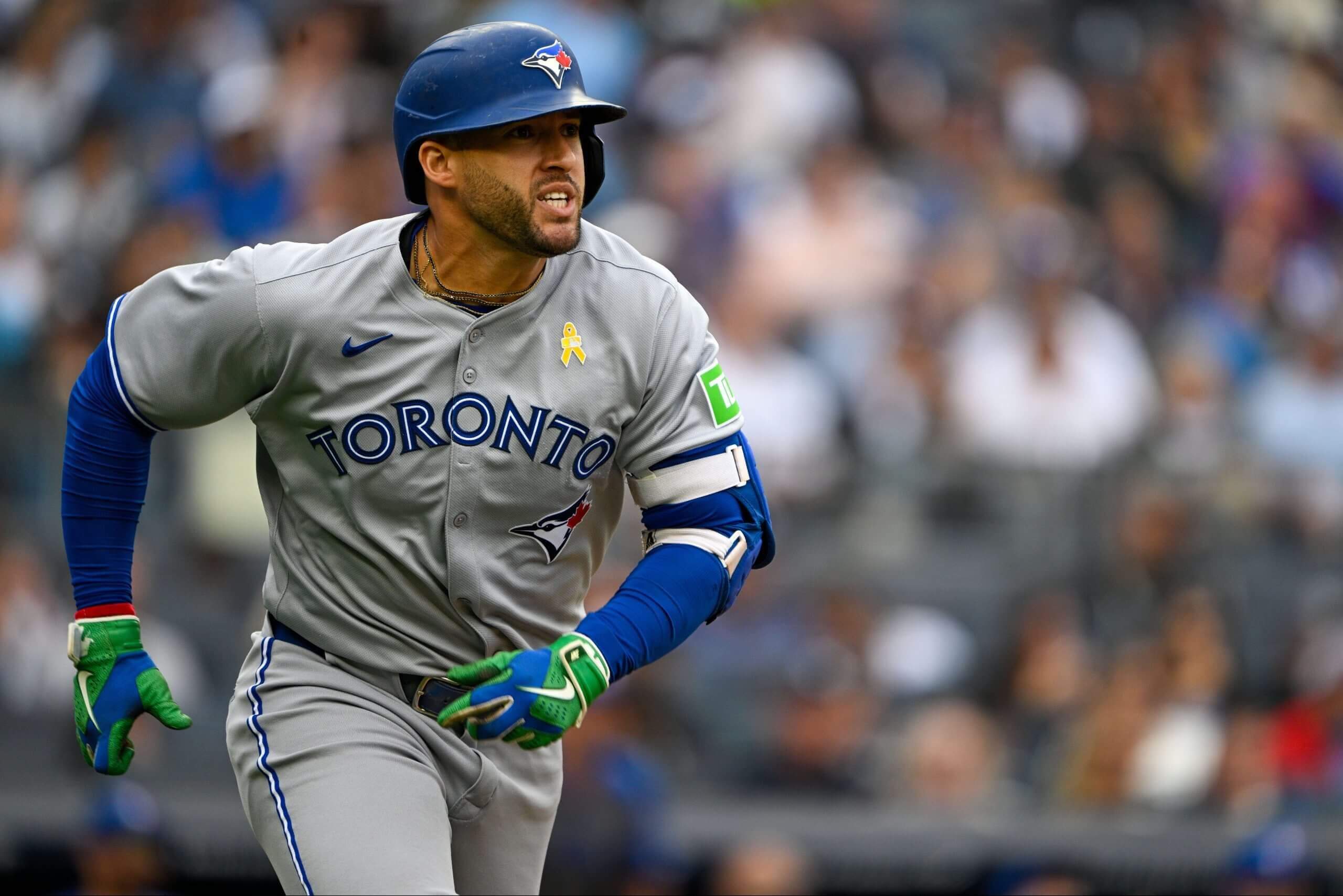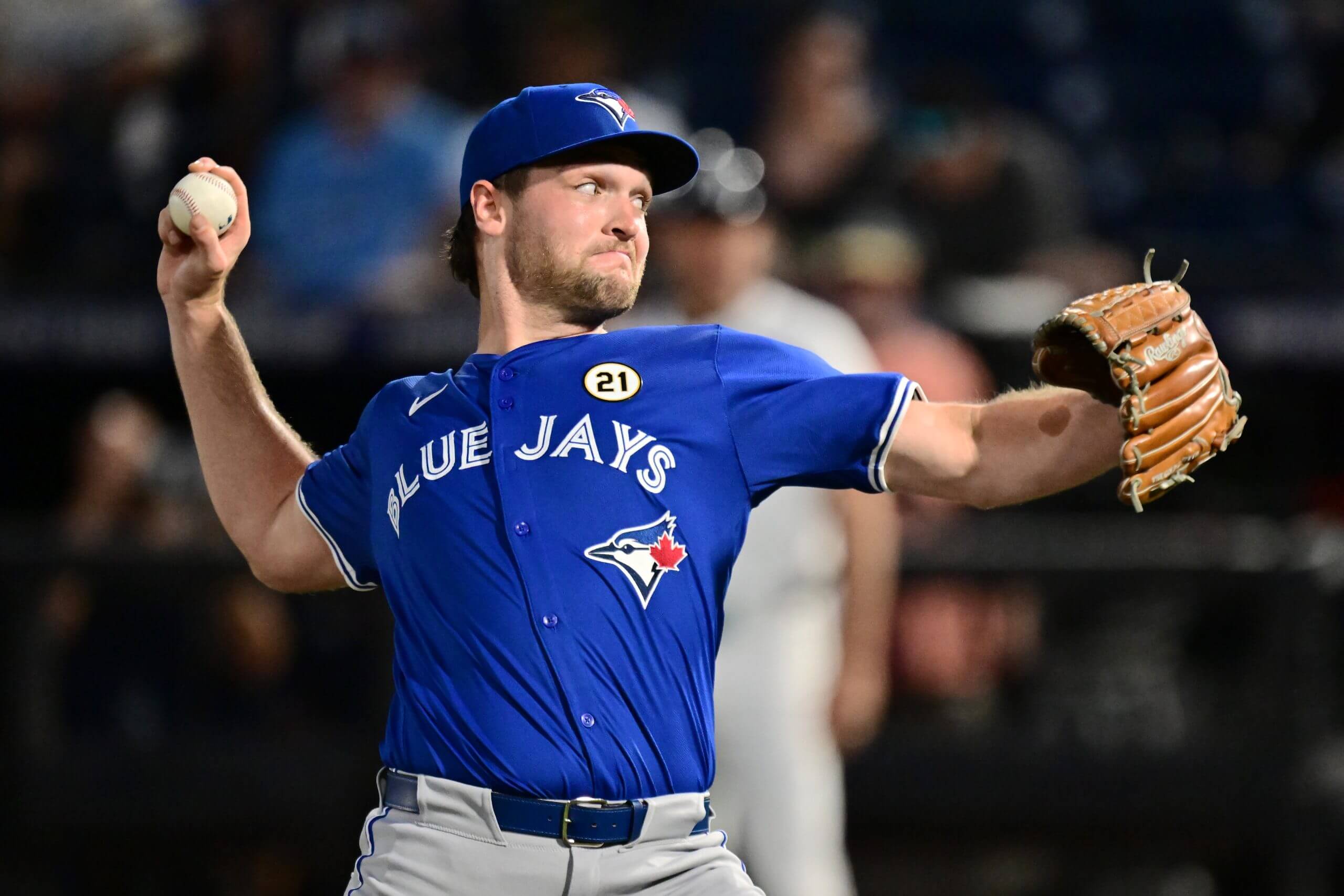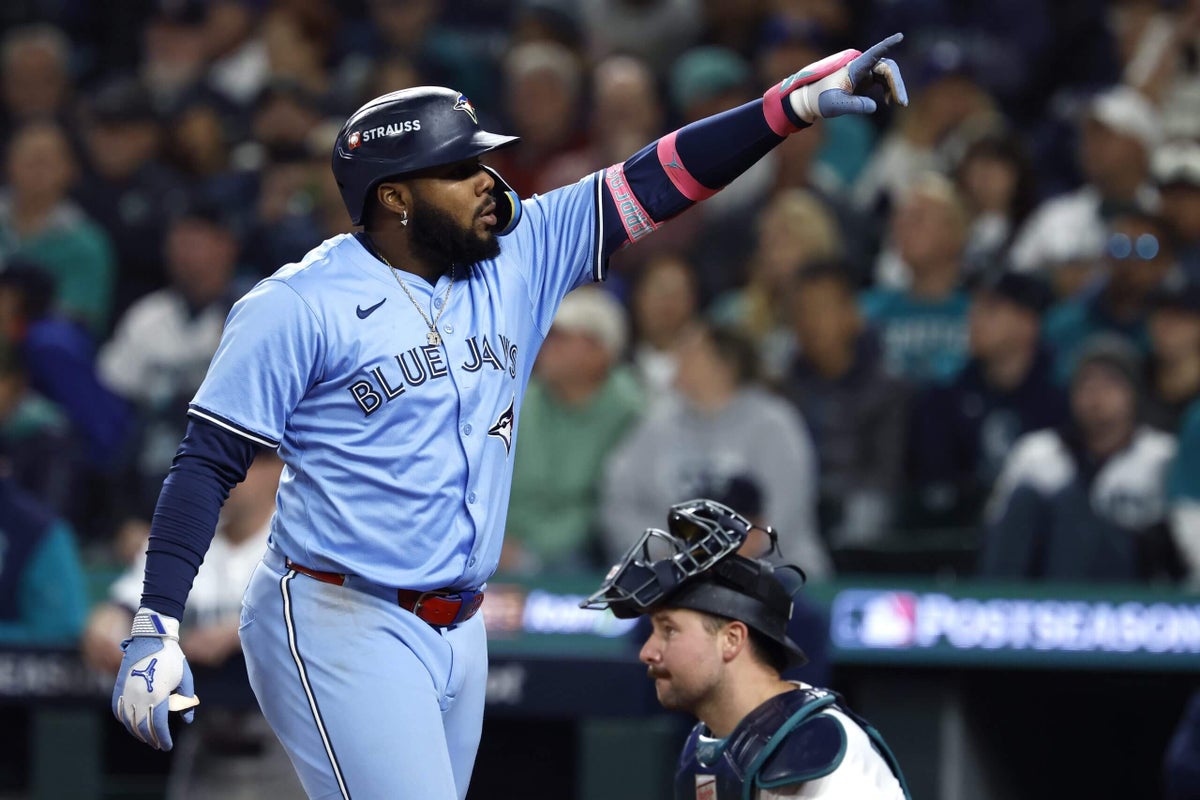In April of 2019, Vladimir Guerrero Jr. got dressed in a Triple-A ballpark and tried to answer the question that would determine the immediate future of the Toronto Blue Jays: Was he ready for the big leagues?
“I couldn’t tell you because I’m not there yet, so I wouldn’t know,” Guerrero said. “But I’d want to tell you that I am ready.”
He was. Two weeks later, he arrived, 20 years old and still not fully formed as a big league hitter, but already an unmistakable linchpin for whatever would come next. The Blue Jays would build around him and see where this kid called Vladdy could take them.
He’s now taken them to the World Series.
After winning Game 7 of the American League Championship Series on Monday night, the Blue Jays are back in the World Series for the first time since Joe Carter’s walk-off home run in 1993. Guerrero is now 26 and the centerpiece of the franchise.
A decade ago, when a different generation of Blue Jays players tried to win a championship, the pennant always eluded them. They twice came close but fell short each time. Building a roster that could finally do it — that could reach the World Series for the first time in more than 30 years — took more than a decade. And it started with the kid at first base.
Step 1 — Find the face of the franchise
- Signed 1B Vladimir Guerrero Jr. in July of 2015
The top international amateurs sign as teenagers. Some are future stars. Many are total busts. In 2015, the Blue Jays went all-in on the 16-year-old son of a Hall of Famer, giving Vladimir Guerrero Jr. $3.9 million — more than they were technically allowed to spend — to sign out of the Dominican Republic. They traded two prospects to the Dodgers for extra international pool money to help offset the cost.
That 2015 international class was correctly identified as an elite collection of talent, but of the 13 players who received at least a $2-million bonus, only Guerrero has become a true star. The other standouts from that year — Juan Soto, Fernando Tatis Jr., Yordan Alvarez, Jazz Chisholm Jr., and others — were all sub-$2 million signings, many signing for much less than what the Blue Jays gave Guerrero. The others who got such massive bonuses have largely faded from relevance.
Guerrero, though, has lived up to his name. Still just 26 years old, he’s been an All-Star the past five seasons in a row, and in that time, only Bryce Harper and Freddie Freeman have produced a higher wRC+ at first base (and even those two haven’t been much better). Guerrero’s 14-year, $500-million extension kicks in next season, and he’s been one of the game’s top performers this postseason.
Step 2 — Keep building the young core
- Drafted SS Bo Bichette in June of 2016
- Signed C Alejandro Kirk in September of 2016
The Blue Jays largely whiffed on their top two draft picks in 2016, but they made up for it with their third pick, shortstop Bo Bichette, who signed for an over-slot bonus and emerged almost immediately as one of the game’s top prospects. Bichette has been the Blue Jays’ primary shortstop since 2019, and after a disappointing 2024, he was back among the game’s best at the position this season. He’s so far missed the postseason with a knee injury, but a World Series return is possible. It could be a fitting farewell before he becomes a free agent next month.
Also in 2016, the Blue Jays struck gold — again — on the international market. Because they’d overspent on Guerrero the year before, the Blue Jays were not allowed to spend heavily on the 2016 IFA class, but they nevertheless landed a gem in 17-year-old Mexican catcher Alejandro Kirk (they also signed current Marlins infielder Otto Lopez and Diamondbacks catcher Gabriel Moreno; more on him in a bit). Kirk didn’t look the part of an elite prospect, but he hit his way onto the radar and eventually to the big leagues. He’s now a two-time All-Star and recently signed a five-year extension.
Step 3 — Turn the page
- Lost Edwin Encarnacion to free agency in November of 2016
- Lost José Bautista to free agency in November of 2017
- Traded Josh Donaldson in August of 2018
- Lost Marco Estrada to free agency in November of 2018
- Traded Russell Martin in January of 2019
- Traded Kevin Pillar in April of 2019
- Traded Marcus Stroman in July of 2019
When the Blue Jays made the playoffs in 2015 and ’16, it was with an entirely different generation of players. Those Blue Jays teams were built around José Bautista, Josh Donaldson and Edwin Encarnacion. They had star power.
By the time Guerrero arrived in April of 2019, though, only Marcus Stroman remained from the previous core. Even Stroman had been traded by the time Bichette made his debut that July. After nearly winning the pennant in ’15 and ’16, the Blue Jays weathered three seasons of losing records before reemerging as a playoff team with essentially an all-new roster in 2020. They’ve been building upon that new core ever since.
Step 4 — Add a veteran bat
- Signed George Springer in January of 2021

George Springer had a bounceback year in 2025, leading the Blue Jays in many offensive categories. (Mark Smith / Imagn Images)
Having returned to the playoffs in 2020, the Blue Jays stopped their rebuild and began building toward a championship. In the winter of 2020-21, they signed Robbie Ray, nearly traded for Francisco Lindor, then signed George Springer to a six-year, $150-million contract that was, at the time, the largest deal in franchise history (the team also added Marcus Semien, Kirby Yates and Steven Matz that winter).
Springer’s time with the Blue Jays has been inconsistent. He’s dealt with injuries and had a career-worst .674 OPS in 2024, but at 36 years old, he’s been resurgent this season. Only Aaron Judge and Shohei Ohtani produced a higher wRC+ in the regular seasons, and Springer’s 5.2 fWAR was eighth-best in the American League. The Blue Jays signed Springer to help lead them back to the World Series, and in the next-to-last year of his contract, he’s done exactly that.
Step 5 — Finally land an ace
- Signed SP Kevin Gausman in December of 2021
Two offseasons in a row — after the 2019 season, and again after 2020 — the Blue Jays tried and failed to sign Kevin Gausman. Each year, he took a one-year deal with the Giants, betting on himself and building value before the Blue Jays finally got him on a five-year, $110-million deal.
In the first four years of that contract, Gausman has delivered the fourth-most innings and third-most strikeouts in baseball. He’s pitched to a consistent 3.48 ERA — no season higher than 3.83 or lower than 3.16 — while making at least 31 starts each year. FanGraphs WAR labels him the fourth-most-valuable starter in baseball during his time in Toronto, behind only Zack Wheeler, Logan Webb and Tarik Skubal.
Step 6 — Add role players wherever you can find them
- Drafted OF Davis Schneider in 2017
- Drafted 3B/OF Addison Barger in 2018
- Signed OF Nathan Lukes in November of 2021
- Drafted RP Mason Fluharty in 2022
- Signed INF Ernie Clement in March of 2023
- Purchased RP Brendon Little in November of 2023
While building this team, the Blue Jays had their share of prospect disappointments. Some flopped (Nate Pearson, Jordan Groshans, Anthony Alford), and others fizzled (Cavan Biggio, Alek Manoah), leaving the Blue Jays to round out their roster in unexpected ways.
Lukes and Clement were signed as minor league free agents, and both have become lineup regulars. Fluharty was a fifth-round pick who’s settled into the bullpen, Barger was a sixth rounder who hit 21 home runs this year, and Schneider was a 28th-round pick who was twice exposed to the Rule 5 draft before spending the past three years with the Blue Jays. Little, a former first-round pick, was acquired from the Cubs for cash considerations and this season led the American League in relief appearances.
Step 7 — Give a big trade a little time
- Traded for CF Daulton Varsho in December of 2022
Initially, this trade looked like a disaster for the Blue Jays. Catcher Gabriel Moreno and corner outfielder Lourdes Gurriel Jr. went to the Diamondbacks in the deal, and the Diamondbacks immediately went to the 2023 World Series with Gurriel making the All-Star team and Moreno winning a Gold Glove. Daulton Varsho, meanwhile, had an 84 OPS+ his first season with the Blue Jays.
But Moreno and Gurriel haven’t been as valuable in the two years since, while Varsho has solidified himself as one of the game’s best defensive center fielders. He also delivered a career year at the plate this season (albeit in limited playing time due to injury), and he was an offensive beast in the division series win against the Yankees.
The trade remains a debatable move — Moreno is still just 25, while Varsho is a free agent after next season — but the Blue Jays had catching depth and needed a left-handed outfielder, and the trade has now helped two different teams get to the World Series.
Step 8 — Find someone (anyone!) to stabilize the rotation
- Signed SP Chris Bassitt in December of 2022
The Blue Jays have been trying to build a viable rotation for years. It started before they added Gausman, and it’s continued ever since. The Blue Jays, since 2019, have signed or traded for Hyun Jin Ryu, Taijuan Walker, Robbie Ray, Ross Stripling, Steven Matz, José Berríos, Yusei Kikuchi and Cuban right hander Yariel Rodríguez (who’s now in their bullpen). They’ve also developed first-round picks Nate Pearson and Alek Manoah to fleeting success.
Building and maintaining a rotation has been an ongoing process with inconsistent results. Since 2022, the Blue Jays rank 12th in the Majors in rotation ERA, and they ranked 20th this year. Berríos has stuck around, but his performance has been up and down, and he’s been hurt this postseason.
Of that group notable rotation additions, Bassitt is the one who’s stuck to help the Blue Jays make this run to the World Series. In his three seasons in Toronto, Bassitt pitched to a 3.89 ERA while always making at least 31 starts and averaging more than 181 innings. Bassitt has been rarely dominant, but he’s been the durable workhorse the Blue Jays needed.
Step 9 — Spend a bunch more money
- Traded for 2B/SS Andrés Giménez in December of 2024
- Signed SP Eric Lauer in December of 2024
- Traded for CF Myles Straw in January of 2025
- Signed RP Jeff Hoffman in January of 2025
- Signed OF Anthony Santander in January of 2025
- Signed SP Max Scherzer in February of 2025
- Traded for RP Luis Varland in July of 2025
- Traded for RP Seranthony Domínguez in July of 2025
- Traded for SP Shane Bieber in July of 2025
- Claimed INF Isiah Kiner-Falefa off waivers in August of 2025
These are only some of the moves the Blue Jays made in the past 12 months. Notice that three of them — Lauer, Scherzer and Bieber — are continuations of Step 8: the constant search for starting pitching.
Although the Blue Jays have had some high-profile misses in free agency (most notably Shohei Ohtani in 2023), and some of this year’s moves are off to questionable starts (Santander hit just six homers), the team clearly has been trying to build a winner around the current core. Bichette becomes a free agent this offseason, and Springer and Gausman depart after next year, but the front office has been busy building around them.
According to Cot’s Contracts, the Blue Jays jumped from the 10th-largest payroll in 2024 to the fifth-largest this season.
Step 10 — Bring the kid to The Show
- Drafted SP Trey Yesavage in July of 2024
- Promoted Yesavage to Toronto in September of 2025

Trey Yesavage’s emergence has been key to the Blue Jays’ postseason run. (Julio Aguilar / Getty Images)
Heading into the 2024 draft, many online rankings had East Carolina starter Trey Yesavage going among the top 10 to 15 picks. He had some medical concerns, but he threw hard, threw strikes, and had a “nasty splitter” according to The Athletic’s Keith Law. When he fell the Blue Jays at No. 20, Toronto offered an above-slot bonus of more than $4 million to sign.
Less than 100 minor league innings later, Yesavage was in the big leagues. Just three Major League starts after that, he was throwing an 11-strikeout gem in Game 2 of the division series. On Sunday, he was terrific again, striking out seven in 5 2/3 innings of the must-win Game 6.
After slowly building this roster for more than a decade, the Blue Jays fast-tracked a 22-year-old kid, and it was the final piece that got them back to the World Series for the first time in more than 30 years.
